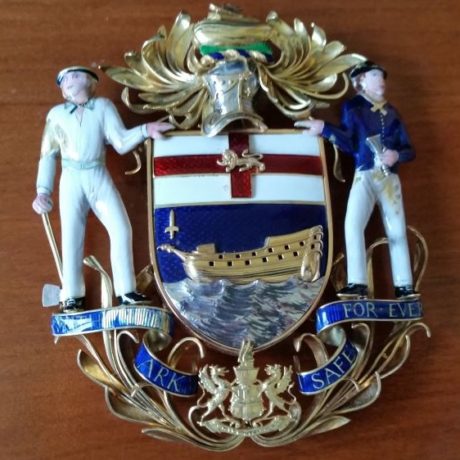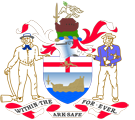Categories
- All
- Badges
- Banners
- Beadle Staffs
- Books, Antiquarian and Fine Bindings
- Bowls, Cousch, Quaiches and Vase
- Boxes
- Candlestick and Candelabra
- Chargers, Dishes, Plates & Salvers
- China & Porceline
- Clocks
- Cups, Flagons and Tankards
- Goblets – Decorated
- Goblets – Glass
- Goblets – Silver
- Gowns and Preaching Scarf
- Inkstand
- Instruments and Tools
- Medal display
- Medals Commemorative
- Miscellaneous Tableware
- Model Aircraft
- Model Ships
- Model Statues
- Muniment Chest
- Paintings, Engravings & Prints
- Shrieval Badge Display
- Speech Timer
- Swords and Knives
- Wine Jugs
Prime Warden’s (formerly Master’s) badge
In 1876, at the beginning of the resuscitation of the Company, members were increasingly inviting prominent guests to Company dinners and attending other City dinners, and it was decided that the Master should have a badge similar to those of the Masters of other Companies. At a Court meeting at the London Tavern on 24th. February 1876 “it was resolved unanimously that a Master’s Badge be procured at an expense not to exceed £52:10:0”. A design by Mr. Maurice Emanuel, a Portsmouth silversmith , was accepted, and Mr. Emanuel was obliged himself to write in the Minute Book “Gentlemen, we undertake to supply you with the gold enamelled badge for your Company in 18ct. gold for the sum of fifty guineas…”. Emanuel was admitted to membership of the Company on 1st.March. Four months later it was noted that “Messrs Emanuel’s bill, which included an extra £10:10:0 beyond the contract, was referred to Mr. K.Kyffin Freeman, who kindly undertook to arrange the matter with Messrs Emanuel”. It is not recorded how the matter was settled.
The badge was delivered by 22nd. March 1876, theoccasion of possibly the Company’s greatest Court Dinner to date, attended by the Lord Mayor, and was worn that night by the Master, Mr. George Tatum.
As originally made, the badge was based on the painting of the Shipwrights’ Arms commissioned in 1782 (item 005/1782), complete with supporters. In 1877 the Company acquired the original Grant of Arms made in 1605 to the Company of Shipwrights of Redriff (item 002/1877). The Worshipful Company had, quite improperly, adopted these well known arms about 1700 when the Redriff Company went out of existence after the long legal battle between the two, but the precise description and delineation of the arms had not been known. At a Court meeting at the Guidhall Tavern on 19th. November 1878, the Master “informed the Court that a Mr. James R. Brown, a manufacturing goldsmith of Newcastle Place, Clerkenwell and a member of this Company (he was admitted 18th. April 1877) had been good enough, at his own cost, to alter the Master’s Badge so as to make the Shield of Arms accord with the Grant…” This probably means simply that the representation of a ship on the shield was altered from an 18th.C ship of the line with flags flying, to a smaller, older bare hull facing the other way.
The back of the badge was originally engraved :
MASTER’S BADGE
The Worshipful Company
of
Shipwrights
George Tatum Esquire, MASTER
William Broomham Esquire
WARDENS
William S Page Esquire
22nd. MARCH 1876
REMADE MARCH 1882
Lord John Manners GCB
MASTER
There appears to be no record of the alterations made in 1882 but it was possibly then that the supporters were removed – perhaps on the realisation that they were not included in the 1605 Grant.
After the First World War, the Company was fully aware that it was using the Arms of the Redriff Company without any legal authority. In 1920 it obtained a Royal Warrant directing the Deputy Earl Marshall that the Company could use them legally with such differences as the Deputy Earl Marshall should decide. On 24th. June 1920 Garter King of Arms in a new Grant of Arms (item 033/1920) directed that the Arms of the Redriff Company should be differenced by the addition of the Golden Sword of St. Paul, Patron Saint of London, above the prow of the ship on the shield and on the prow of the Ark on the crest. The first of these was painted on the shield of the Master’s Badge, but the second, which would have required a completely new piece of metal, was not added.
In 1982, on the occasion of the bi-centenary of the granting of the Company’s Livery, a new Grant of Arms (item 168/1983) was obtained, officially adding supporters based on those in the 1782 painting. The Master’s Badge was altered accordingly by Mr. David Thomas, a Chelsea goldsmith, the opportunity being taken to add the missing sword to the Ark.
The Master’s Badge was originally hung from a ribbon. This was probably pale blue. Today on formal occasions it is hung from the Prime Warden’s Chain (item 084/1948) and on informal occasions from a dark blue ribbon.
(016/1876)






